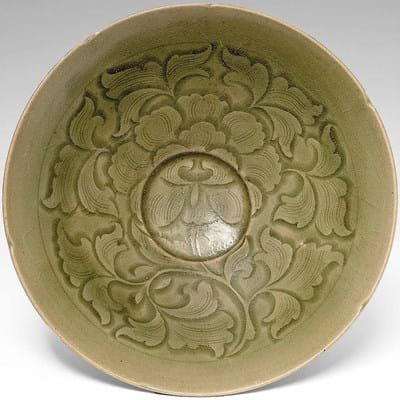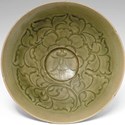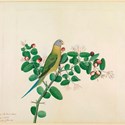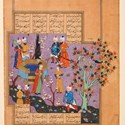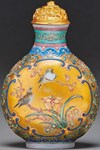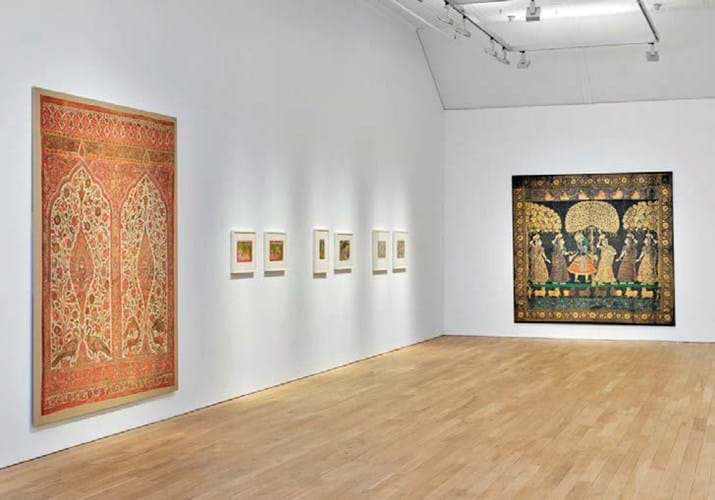
A view of Francesca Galloway and Luhring Augustine Tribeca’s exhibition Court, Epic Spirit.
Image: Luhring Augustine Tribeca in conjunction with Francesca Galloway, photo Farzad Owrang
The 22 taking part in person are a mix of resident dealers in their own premises and guest exhibitors taking gallery space for the occasion. Note that for many of the galleries admission is by prior appointment.
On offer is a broad mix of Asian works from ancient to Contemporary, Indian and south Asian to Chinese, Japanese and Korean, spanning paintings, ceramics, works of art, textiles, metalware and more.
Pictured here is a taste of what will be on offer from five of the exhibitions being staged by participants this spring.
Zetterquist Galleries
Zetterquist Galleries, New York dealer in Asian ceramics and works of art, will be holding an exhibition in its East 66th Street premises devoted to Chinese ceramics from the Tang through to the Yuan dynasty with most of the exhibits sourced from US and European collections over the past two years. Prices range from $4000-45,000.
Among the highlights is this Tang dynasty white Xing-ware bottle vase (above) sourced from the collection of a prominent New York family and with a provenance to Robert Hatfield Ellsworth and A W Bahr. From the Song celadon wares comes this large Northern Song bowl (960-1127), masterfully carved with a peony pattern and covered in a Yaozhou celadon glaze (above).
Francesca Galloway and Luhring Augustine Tribeca
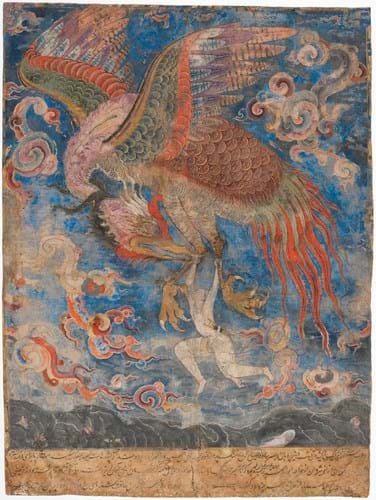
An imperial Mughal illustration to the Hamzanama from c.1565, painted in pigments and gold on cotton with a paper support for the text, folio size 2ft 4in x 21in (71 x 53cm). One of the paintings on show at Francesca Galloway and Luhring Augustine Tribeca’s exhibition Court, Epic Spirit.
London dealer Francesca Galloway and New York dealer Luhring Augustine Tribeca are collaborating to present an exhibition titled Court Epic Spirit: Indian Art 15th-19th Century which is now open and runs through AWNY until March 24 at the White Street Tribeca location.
The title of the exhibition refers to three key lenses through which the multi-faceted arts of India can been viewed.
Among the highlights to be featured will be a 17th century panel from a royal tent, part of a group thought to have been produced in the Deccan; a rare mid-19th century Deccani painted cotton temple cloth or pichhvai painted with a scene of Krishna playfully demanding a toll from the gopis and a group of 17th century ragamala paintings that evoke musical modes.
Another stand-out item will be a 16th century painting from the Mughal epic the Hamzanama (The Story of Hamza) which was commissioned by the young Emperor Akbar. This particular scene depicts Amir Hamzir clinging to the legs of Rukh, a giant bird, so that he can carry him home across the sea. Not only is it the only known folio depicting of this particular episode but it is also notable for being attributed to Dasvant, a master artist of the Imperial atelier.
Prices start from $20,000 and the exhibition is accompanied by an illustrated catalogue.
Joan B Mirviss

Nami-Wave, 2021, measuring 18 x 7 x 4½in (46 x 18 x 11.5cm), one of Kondo Takahiro’s marbleised porcelain works on show in the exhibition Making Waves at Joan B Mirviss.
During AWNY, New York dealer Joan B Mirviss will be presenting Kondo Takahiro: Making Waves, an exhibition of sculptural works at the dealer’s East 78th street gallery. There are 30 new works in marbleised porcelain by this Contemporary artist in the show, from human-sized monolithic works to teabowls. Prices range from $8000-80,000.
Takahiro (b.1958), who is descended from a line of Kyoto blue and white porcelain masters, has always been focused on water, especially as a life-giving and spiritual force. However, following the devastating 2011 Tōhoku earthquake and tsunami, the artist gained new perspective on the dichotomy of water's creative and destructive powers.
In a departure from his earlier Wave artworks, Kondo incorporates a white clay into his marbleisation technique and its combination with the darker clay that appears to flow down the surfaces creates an ink on paper effect transforming the works into what he calls “porcelain ink paintings”. The works feature his signature gintekisai (silver mist) glaze resembling a morning dew effect.
Displayed alongside Takahiro’s works will be ink paintings by the Chinese artist Bingyi (b.1975) presented by the Beijing and New York gallery INKstudio.
Sebastian Izzard LCC Asian Art
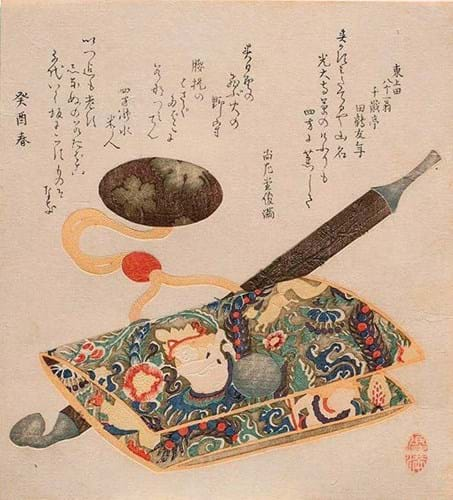
One of the surimono woodblock prints that features in Sebastian’s Izzard LCC Asian Art’s spring exhibition is this 8 x 7¼in (20 x 18cm) print from 1813 of a pipe and decorative tobacco pouch with ojime bead and manju netsuke by Kubo Shunman (1757-1820). Commissioned by members of the Yomo (Four Directions) group, the poems are signed: Senzaitei Tazu Tomotoshi, Shosadō Shunman and Yomo Takisui Komehito.
New York dealer Sebastian Izzard LCC Asian Art will be holding a spring exhibition devoted to surimono at its East 76th Street Gallery during AWNY.
Surimono are the privately commissioned counterparts to commercial Japanese woodblock prints of the late 18th-early 19th centuries. Produced in small numbers for a mostly educated audience of literati, cost was not a primary consideration in their production, unlike in commercial publishing.
Accordingly, they were often more experimental in subject matter and treatment – and extravagant in printing techniques. The poetic texts which often appear on them were as important as the illustrations and because they were privately printed and distributed, surimono neither had to be approved by the censor nor bear publisher’s seals.
The shikishiban, or square paper shape, soon became the format of choice among the many artists hired to design surimono. By the turn of the 18th and 19th centuries surimono had evolved into two main forms: as an announcement or invitation to a special event; and as prints individually commissioned by poets or poetry groups to serve as a vehicle for illustrating their verses. The amateur poets who paid to have their poems included were often wealthy and their patronage was a lucrative source of income for artists.
Two artistic groups dominated surimono production: one led by group Katsushika Hokusai (1760-1849) and his school, the other by the artists led by Utagawa Toyokuni (1769-1825) and after his death, Utagawa Kunisada (1786-1865).
Another highlight on show at the gallery will be a rare complete first edition set of Hiroshige’s (1797- 1858) Eight Views of the Suburbs of Edo thought to have been completed around 1837-38 when the artist was aged 40. It was commissioned by the Taihaido Poets Society and the eight landscapes each feature a beauty spot in the far suburbs of Edo with the best poems composed by the group selected for inclusion on the landscapes. Only first-edition sets include all the poems.
Prices for most of the prints in the exhibition range from $10,000-45,000, with the exception of the Hiroshige set, and the show is accompanied by an illustrated catalogue.
Oliver Forge and Brendan Lynch
Oliver Forge and Brendan Lynch from London will be participating in AWNY this year at 67 East 80th Street bringing India and Iran: Works on Paper, a selection of 30 paintings reflecting court traditions, both Hindu and Muslim, accompanied by a catalogue.
The highlight of the show, with a price on application, is a rare large page from a Safavid manuscript of c.1576-7, The Accession Shahnama of Shah Ismail II of Iran. The folio depicts Kay Khusrau, mythical king of Iran and the hero of the Shahnama, meeting Piran, vizier to king Afrasiab of Khotan, an ancient Silk Road kingdom in present day Xinjiang, China. The painting, which uses a palette of blues, reds, yellows and greens on an unusual mauve ground, is signed by the court artist Zayn al’Abidin who contributed six paintings to the manuscript.
Other works in the exhibition include an early 18th century portrait of Timur, conqueror and founder of the Mughal royal line; a stippled equestrian portrait of Sarup Singh, one of the last great patrons of the Mewar court at Udaipur, by Parasuram, which is dated 1859 and was formerly in the British Rail collection, and a Company School watercolour from the celebrated album produced for Lady Impey, the wife of Elijah Impey chief Justice of Bengal.



